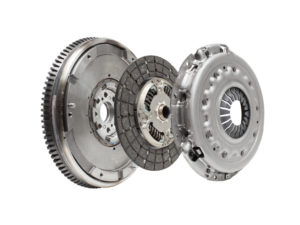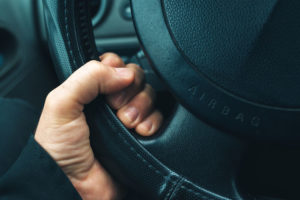
The Pressure Plate (Left) Pushes the Clutch Plate (Right).
While automatic transmission vehicles have certainly spoiled us, learning to drive with a stick shift is still a valuable endeavor. To do so however, you (or your loved one) will need to know how to operate the clutch. The clutch plays an invaluable role in protecting your car as your change gears, and it provides you with better control as you drive a manual transmission vehicle. Below is a quick guide to teach you what a clutch is and how it operates. We’ll also talk about maintenance and delaying that costly clutch repair! [FYI: even though automatics do have clutches, we’ll be focusing on manual transmission vehicles.]
How Do Clutches Work?
The clutch is composed of three primary parts: the fly wheel, clutch plate (or disc), and the pressure plate. The flywheel is connected to the car motor and is constantly turning. This is why your engine continues to run, even while your wheels aren’t rotating. Against the fly wheel fits a special disc-shaped plate, which helps turns with the circular movement of the fly wheel. Finally, the pressure plate (you guessed it) applies pressure against the clutch plate so that it connects with the fly wheel. If you’re feeling confused, don’t worry. Here are the numerical steps.
- The pressure plate pushes the clutch plate against the flywheel, which turns as the motor runs.
- When the clutch plate contacts the flywheel, the clutch plate spins.
- At this point, the engine has been connected with the wheel shaft, and the wheels begin to move.
The exception to this operation comes when you press the clutch pedal in order to change gears. As you press the pedal, the pressure plate pulls back from the clutch plate, which in turn disconnects from the flywheel. This temporarily releases the wheels from the power of the engine, enabling the driver to switch gears.
Why the Clutch is Necessary

Timely Clutch Repair is a Must for Any Vehicle.
Is it bad to shift without the clutch? Without the clutch, shifting gears becomes much more laborious and damaging for your transmission. Even if you have very precise timing in your shifts, you will still put more strain on your transmission. If your timing is off, you’ll damage your gears as well. To play it safe, just use your clutch and gearbox as intended.
Can you drive a car without a clutch?
Even cars with automatic transmission utilize clutches to aid the gear system, and you certainly should use it for a manual. While you can start a vehicle, upshift, and even downshift without the use of a clutch, it is not recommended. Again, it places too much strain on your transmission and can lead to some early part replacements.
What are the Symptoms of a Bad Clutch?
Any of the following symptoms will show when your clutch is going bad.
- Stranges noises when the clutch pedal is pressed
- Jerky pedal action
- Engine power, acceleration power mismatch (bark, but no bite)
- Temporary loss of acceleration ability
- General challenges with changing gears
If your clutch is regularly slipping as you switching into a higher gear, it’s likely a signal of a degraded. When you press the pedal with a weakened clutch, you may start to hear startling grumble sounds or squeaks. You may also notice that your engine is showing high RPMs, but acceleration is lacking. As the clutch starts to slip more, you’ll notice more and more instances of temporary loss of acceleration.
You may eventually experience a complete loss in acceleration capability. If you’re on the road and your car performance is fading quickly, stop for repairs. Play it safe. A little car maintenance in Dallas, TX, is better than a breakdown in Arizona.
How Do I Know When My Clutch Needs Replacing?

Worn Clutches Can Lead to Lost Acceleration.
Any of the symptoms above should let you know its time to change that clutch. You should especially pay attention to pedal changes and loss of acceleration, as these can greatly affect your ability to drive (and your personal safety). Be sure to avoid placing unnecessary stress on your clutch and gearbox, as these symptoms could pop up even with a relatively new clutch component.
If your clutch is slipping a lot when you release the pedal, it may be a sign your system is burning out. Can you smell a clutch burning? If the slippage continues for long enough, yes. It’s not a pleasant smell.
How Does a Clutch Wear Out?
One of the of the most detrimental habits for your clutch is “riding it” (leaving your foot on the pedal all the time). Unless you are changing gears, keep your foot rested on the floor or to the side. A half-pressed clutch pedal actually burns out the clutch plate. Also, avoid releasing the clutch pedal before you’ve completely changed gears. Engaging the clutch on hills to brake the car is another big no-no.
On the flip side, you can take some stress off your clutch with a few simple habits.
- Release the clutch gradually, not abruptly.
- Parking in neutral with the E-brake.
- Starting in first gear after complete stops.
- Decelerating long before coming to stop lights.
Schedule Your Clutch Repair Today!
Timely clutch repair will protect you on the road and help you avoid any lapse in driving performance. To learn more about clutch repair, or to schedule an appointment with one of our L.A. NTX Transmissions pros, give our team a call at (310) 672-8131!
